Despite work across more than four decades, contemporary Italian painter Leonardo Cremonini (1925-2010) is mostly unknown outside of certain art circles.
His large, vibrant canvases portray human figures, household scenes, still lifes and landscapes and have a strong and immediate effect on the viewer.
The Fairfield University Art Museum, working with The William Louis-Dreyfus Foundation Inc., is bringing his visions to the public with a new exhibit, “Leonardo Cremonini — Timeless Monumentality: Paintings from The William Louis-Dreyfus Foundation” (through March 4).
William Louis-Dreyfus — the late French-born businessman who was the father of actress Julia Louis-Dreyfus — was a passionate collector and arts educator, particularly when it came to Cremonini’s works.
“William was interested in the work of contemporary artists who are ‘not your usual suspects,’” said Mary Anne Costello, manager of the foundation’s art collection, housed in a permanent space in Westchester County.
The collection contains the work of 200 artists and numbers 4,000 pieces. About 600 works are on display at any one time, many of them by Cremonini. The exhibit at Fairfield University features close to 40 of his works, from the 1950s through the ’90s.
Linda Wolk-Simon, the Frank and Clara Meditz director and chief curator of the Fairfield University Art Museum, described the origins of the exhibit.
“I was fortunate enough to be able to talk to Mr. Louis-Dreyfus on a personal level,” she said. “About a year and a half ago, he invited my husband and me to see his personal collection at the foundation gallery. Cremonini’s work was very distinctive and instantly recognizable.”
Wolk-Simon said Louis-Dreyfus was excited about collecting Cremonini. “I had just started at Fairfield and the idea of a show featuring Cremonini was born in a kind of perfect storm. The works were just amazing and it was plain to see that Mr. Louis-Dreyfus was actively engaged in introducing the artist to more people.”
The Fairfield Univerity show is the first devoted to the artist in more than two decades and is being presented at a moment when modern and contemporary painting have eclipsed earlier art in terms of popularity. Wolk-Simon said she hopes the exhibit will serve to introduce Cremonini to a new audience and foster a critical reappraisal of his art.
“(He) was a generous and enthusiastic supporter of this exhibition and was energetically involved in its planning until shortly before his death on Sept. 16. It is sad he did not live to see its realization.”
The exhibit is presented in tribute to Louis-Dreyfus, whose foundation supports the educational Harlem Children’s Zone Project — the subject of a recent film, “Generosity of Eye,” made by daughter Julia and her husband, Brad Hall.
Wolk-Simon said Cremonini’s canvases are striking for both their technical mastery and for their distinctive and haunting imagery. Primeval forms, dark, untamed beasts and luxuriant foliage dominate the artist’s early works. In the l960s, she said, his palette lightened and his figures become more ethereal. Psychologically remote, languid and detached, they are eternally frozen in train cars, bedrooms, bathing huts or on seaside terraces, embraced by a sultry Mediterranean light.
Even when the human figures themselves are absent, their presence lingers in carelessly opened drawers, doors left ajar, discarded clothing and overturned chairs, with vaguely sinister shadows belonging to unseen passers-by promising their imminent return.
“Cremonini, a native of Bologna, lived and worked for much of his career in Paris and experimented in a lot of different styles and genres,” Wolk-Simon said. “He was always a realist but flirted with abstraction. But the Mediterranean elements were always there.”
Added Costello, “Mr. Louis-Dreyfus travelled extensively and started purchasing Cremonini in Europe. He always said he liked to see the hand of the artist in his work and Cremonini’s style lived up to that. He started collecting him in the 1980s in Paris, sending the works home to America. He was very much attracted to their declarative style and vivid color.”
Costello said Cremonini offers “a lot to look at in each work and his subjects run an extensive gamut. Louis-Dreyfus loved Cremonini and collected and supported him for more than 20 years, ultimately collecting more than 100 works.”
Louis-Dreyfus was more than a collector, she added.
“He participated in (the artists’) lives, knew them personally, and supported them throughout their careers,” Costello said. “He helped many artists that were unknown and struggling. In that sense, he was an unusual collector. His artists were engaged with him and there was a real connection.”
For more, visit fairfield.edu/museum and wldfoundation.org.





